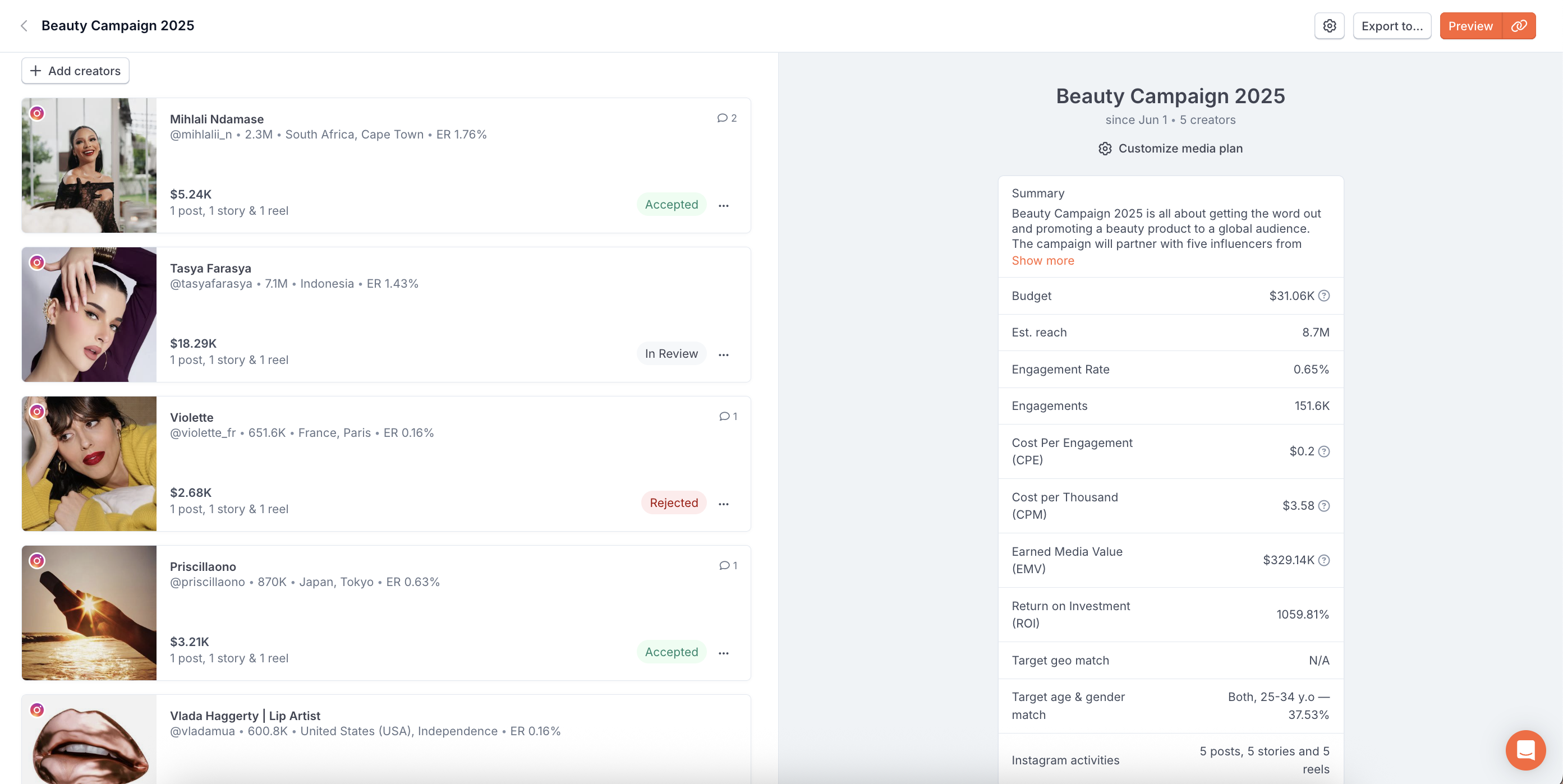
A marketing campaign brief is a document that outlines the core elements of a marketing campaign. It sets the direction by covering goals, target audience, key messages, budget, timeline, and deliverables, providing a clear path for everyone involved. You can think of it as a roadmap to make sure that everyone knows what’s expected and how to move forward with the campaign.
However, creating a comprehensive campaign brief isn’t always easy. It can be tough to find the right balance between providing enough detail to guide the team and avoiding overwhelming them with too much information. Many marketers struggle with aligning team members on campaign goals, ensuring all important aspects are covered, and keeping the brief flexible enough to adjust as needed. This can sometimes make the process feel more like a chore than a helpful tool.
One area where a solid campaign brief becomes essential is influencer marketing. This sub-sector of marketing requires a clear understanding of the influencer’s role, expectations, and deliverables. We’ll explore this in more detail later on.
There are different ways to create a campaign brief, and each method can match your personal style and preferences. Some marketers enjoy taking a hands-on approach, carefully crafting each detail, while others prefer quicker, more practical methods like using templates or AI influencer marketing tools. No matter your approach, we’ll look at these different options so you can choose the one that fits your way of working best.
The importance of a campaign brief
A marketing campaign brief is more than just a document. It’s the plan that keeps your campaign focused and organized. It helps everyone involved understand what’s expected and how to move forward, making sure nothing gets lost in the process. Here’s why having a clear campaign brief is crucial:
1. Clarifies the campaign’s goals
A good campaign brief makes it clear what the campaign is trying to achieve whether it’s raising brand awareness, generating leads, launching a new product, or keeping customers engaged. Setting clear goals helps the team stay focused and avoid getting off track.
2. Keeps everyone on the same page
By clearly outlining who’s responsible for what, along with deadlines and deliverables, the brief ensures that everyone (marketers, designers, agencies, and executives) knows exactly what they need to do. This helps everyone work together smoothly and reduces confusion.
3. Guides creative decisions
The brief gives insight into the target audience, key messages, and the brand’s voice. This makes it easier to create content that fits the campaign’s goals and keeps everything consistent, whether it’s social media posts, ads, or emails.
4. Simplifies planning and execution
A campaign brief outlines the goals, audience, strategy, budget, and timeline which makes it easier to plan and execute the campaign. It serves as a roadmap to help the team stay organized and on schedule from start to finish.
5. Tracks progress and results
Including key performance indicators (KPIs) in the brief helps track how the campaign is doing. By setting clear metrics, the team can assess what’s working and make adjustments along the way.
6. Improves accountability
The brief clearly defines who is responsible for what. This helps manage expectations and ensures everyone knows what’s expected of them, reducing misunderstandings and keeping things running smoothly.
In short, a marketing campaign brief is an essential tool for making sure your campaign stays focused and organized. It helps guide the team, keeps everyone on track, and ensures that the campaign achieves its goals.
What should be in a marketing campaign brief
The components of the brief will depend on the campaign and its specific objectives, but here is a breakdown of the main elements you will generally find:
Campaign Overview
This section provides the basic details of the campaign. It includes the campaign name, which should be clear and descriptive. The client or brand is also specified, along with the start and end dates. The budget section will outline the financial resources allocated for the campaign to set expectations and limitations for all involved.
Objectives and Goals
The objectives section explains the main purpose of the campaign, whether it is for brand awareness, lead generation, or product launch. Key Performance Indicators (KPIs) are also set to track progress and determine whether the campaign is achieving its goals.
Target Audience
This part identifies who the campaign is aimed at. It includes demographic details such as age, gender, income, and location, as well as psychographics like interests and lifestyle. Sometimes, buyer personas which are detailed profiles of different audience segments, are created to guide the campaign.
Key Messages
This is where you define the main message you want to communicate through the campaign. The core message should be clear and simple, supported by additional points that reinforce it. The tone and voice of the campaign are also outlined here, whether it is formal, friendly, or humorous, ensuring consistency across all materials.
Marketing Strategy
Here, the channels to be used are listed, such as social media, email, or TV. Specific tactics within each channel are discussed, including the types of content to be created such as blog posts, videos, or infographics. This section also helps guide the overall approach for the campaign and how it will reach the target audience.
Deliverables
This section specifies all the materials that need to be produced, such as ads, landing pages, or graphics. It also assigns responsibility for each deliverable to make it clear who is accountable for each part of the campaign. Deadlines for each asset are set to ensure everything is completed on time.
Timeline
The timeline provides an overview of important milestones in the campaign, such as key dates and events. It also includes scheduled times for reviews and feedback, as well as the launch date when the campaign will go live. This helps keep everyone aware of deadlines and ensures the campaign stays on track.
Budget Breakdown
This section outlines the total budget for the campaign and how it is allocated. It includes distribution across different channels and activities, as well as a contingency fund for any unexpected expenses. This provides transparency and helps manage financial expectations.
Measurement and Evaluation
Success metrics are defined to help assess the campaign’s performance. This includes how success will be measured, whether by engagement, conversions, or another metric. Tracking tools such as Google Analytics or social media insights are specified, along with a reporting schedule to ensure regular updates and adjustments.
Approval and Sign-Off
This section identifies the stakeholders who need to approve the brief and any campaign elements. It details the approval process, including the steps and timeline for obtaining necessary approvals. Once everything is confirmed, a sign-off indicates that the campaign is ready to proceed.
Now that we've covered the key components of a traditional marketing campaign brief, it’s time to zoom in on the specifics of influencer marketing. While many of the elements remain the same, the focus shifts to selecting the right influencers, estimating outcomes, and measuring the return on investment, which we’ll break down next.
Breaking down the influencer marketing campaign brief and its components
An influencer marketing campaign brief is a document that outlines the strategy for partnering with influencers to promote a brand, product, or service. Unlike a traditional digital marketing campaign brief, which generally focuses on broader marketing strategies across various channels, an influencer marketing campaign brief is specifically designed to guide the selection and management of influencers. It outlines the expectations, goals, and deliverables for the influencers, providing a clear framework to measure their impact.
What goes into an influencer marketing campaign brief is a bit different from what you’d find in a general marketing brief. While both briefs include campaign objectives, target audience, and key messages, an influencer marketing brief focuses on influencer recommendations, estimated results like reach and engagement, and the return on investment (ROI) for each influencer involved. Here’s the details of what an influencer marketing campaign brief typically contains:
Influencer Recommendations
This section highlights the influencers that are considered the best fit for the campaign. It includes detailed profiles, such as their follower base, engagement rates, niche, and past campaign performance. The goal is to show how each influencer aligns with the brand and campaign objectives.
Estimated Results
This part predicts key performance metrics, such as estimated reach, engagement, and impressions. These numbers are usually backed by data from similar past campaigns or influencer analytics to give a clear idea of what can be expected in terms of audience exposure and interaction.
ROI Estimates
Here, you’ll find a forecast of the campaign’s return on investment (ROI). This includes how much revenue or value the campaign is likely to generate in relation to the budget. It is essential for justifying the influencer partnership and demonstrating the expected financial outcome.
Engagement Metrics
Metrics like likes, comments, shares, and video views are considered to gauge how well the influencers’ content will resonate with their audience. These are often used to predict the overall impact on brand awareness and customer engagement.
Earned Media Value (EMV)
This measures the estimated value of the media exposure generated by the influencers. It’s a way to quantify how much the campaign is worth in terms of the traditional cost of media placement, giving a better understanding of the campaign’s effectiveness.
Cost Per Click (CPC)
This metric helps assess the efficiency of paid influencer campaigns, if applicable. It’s a way to track how much each click on the campaign-related content is costing the brand, offering insights into the financial performance of influencer posts.
Content Deliverables
The brief specifies the type of content the influencers will create, such as Instagram posts, YouTube videos, or blog posts. It also outlines how many posts will be uploaded, the specific format whether it’s a Reel, Carousel, or static image; and which platforms the content will appear on. This ensures there’s clarity on the exact nature of the content to be delivered and how it fits into the campaign strategy.
4 ways to create an influencer marketing campaign brief
Creating an influencer marketing campaign brief can have its challenges. The biggest hurdle is understanding the campaign’s objectives and knowing which influencers will help meet those goals. Once you’ve got a clear grasp on that, the rest depends on the method you choose. Let’s take a look at the different approaches you can take when creating a brief.
1. Write it manually
If you prefer a hands-on approach, writing a campaign brief manually can give you complete control over every detail. But clearly, it requires a bit more work. Here’s how to go about it:
Understand the campaign project. Start by discussing the campaign’s goals with your client or brand. What do they want to achieve? Brand awareness, product launch, or something else? This is crucial for shaping the rest of the brief.
Identify prospective influencers. Do some research to find influencers who fit the brand’s identity and audience. Look for their engagement rates, niche, and how well they connect with the target audience.
Define the KPIs. Set clear, measurable goals to track the success of the campaign. Think about metrics like reach, engagement, or conversions, depending on what the campaign is trying to achieve.
Include your selected influencers and their performance metrics. For each influencer, add details about their audience, engagement, and previous campaign performance. Also, explain why they were chosen and how they’ll contribute to the campaign’s goals.
Estimate the budget and ROI. Break down the budget into influencer fees, content production costs, and other expenses. Then, estimate the return on investment by projecting how much value or revenue the campaign could generate.
State the type of content and platforms. Specify what kind of content each influencer will create, like Instagram posts, Reels, YouTube videos, or TikTok content.
Make it presentable and convincing. Finally, present the brief in a clear and visually appealing way. Use simple language, well-organized sections, and visuals where necessary. Make sure the brief is easy to read and helps your client or stakeholders understand the campaign’s value.
2. Use generative AI like ChatGPT
 If you're looking for a faster way to create an influencer marketing campaign brief, generative AI tools like ChatGPT can be very helpful. Instead of starting from scratch, you can use these tools to quickly generate a draft based on your campaign’s goals and details. This is useful when you need to present a clear plan to stakeholders without spending too much time on it.
If you're looking for a faster way to create an influencer marketing campaign brief, generative AI tools like ChatGPT can be very helpful. Instead of starting from scratch, you can use these tools to quickly generate a draft based on your campaign’s goals and details. This is useful when you need to present a clear plan to stakeholders without spending too much time on it.
By inputting the main campaign details into ChatGPT, it will help create a draft that includes influencer suggestions, estimated results, and a proposed budget. Once the draft is generated, you can easily fill in the specific details you need.
For example, you can use a prompt like: "Write a structure for an influencer marketing campaign brief for a skincare brand targeting women 25-40. The goal is to increase conversions on Instagram and TikTok. Include sections for influencer selection, content types (e.g., Instagram posts, Reels, TikTok videos), performance metrics, estimated reach, and projected ROI."
To get the best results, try to be as clear and detailed as possible with your prompts. The more information you provide about your goals, target audience, and the influencers you've selected, the more helpful the AI-generated structure will be. Once the brief is created, take the time to review it and make any adjustments to make sure it matches your campaign's objectives and stays true to the brand’s voice.
3. Utilize campaign brief templates
There are many influencer marketing campaign brief templates available online, and they can be a huge time-saver. These templates are often customizable, meaning you can adapt them to fit your campaign’s unique needs. Some templates are free, while others might come at a cost. The main benefit of using a template is that it provides a clear structure, making sure you don’t miss any important sections, like objectives, KPIs, or influencer recommendations.
However, templates come with their own set of limitations. While they can save time, they may also feel a bit too generic. You might find that some sections don’t fully match your specific campaign requirements, and customization will be necessary. Additionally, templates may not always account for more nuanced aspects of influencer marketing, like calculating ROI or estimating performance metrics. That said, templates can still be a great starting point, especially if you're short on time.
4. Use influencer marketing tools
Influencer marketing has come a long way, and today there are tools that can simplify the entire process. These tools not only help with finding and choosing influencers but also assist in creating the campaign brief. One excellent example is HypeAuditor’s Media Plan tool.
A Media Plan is essentially a campaign brief that helps you organize and structure your influencer strategy. With HypeAuditor, you can pick influencers, set your budget, and estimate key results like reach, engagement, and ROI. The great thing is that it calculates these figures automatically, based on the influencers you select.
 What makes this tool even more convenient is that you don’t need to hop between different platforms to manage everything. With HypeAuditor, you can build and share the plan directly with your clients or stakeholders. They can easily approve or reject influencers, so there’s no confusion or back-and-forth. It also saves you the trouble of manually calculating ROI or engagement, as the tool handles that with its AI.
What makes this tool even more convenient is that you don’t need to hop between different platforms to manage everything. With HypeAuditor, you can build and share the plan directly with your clients or stakeholders. They can easily approve or reject influencers, so there’s no confusion or back-and-forth. It also saves you the trouble of manually calculating ROI or engagement, as the tool handles that with its AI.
In short, influencer marketing tools like HypeAuditor make your work smoother and more efficient. They provide a simple way to plan, track, and share your campaign details while keeping everything clear and transparent.
Conclusion
Creating a strong influencer marketing campaign brief is all about presenting your strategy in a clear and convincing way to stakeholders. The brief should lay out all the important details like your chosen influencers, expected results, and the important metrics; so everyone is on the same page.
There are different ways to put together this brief, whether you're writing it from scratch, using AI tools, working with templates, or relying on influencer marketing platforms. Each method has its own strengths depending on your needs and preferences.
At the end of the day, the goal is to provide a comprehensive plan that explains how the chosen influencers will help achieve the campaign’s goals, how their performance will be measured, and what the expected return on investment is. A well-done brief isn’t just a piece of paperwork, it’s a plan that helps guide everything to success. Find the approach that works best for you, and you’ll be on your way to running successful influencer campaigns.













